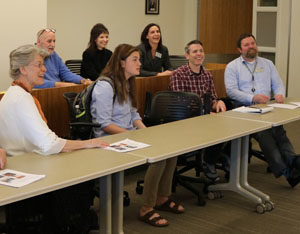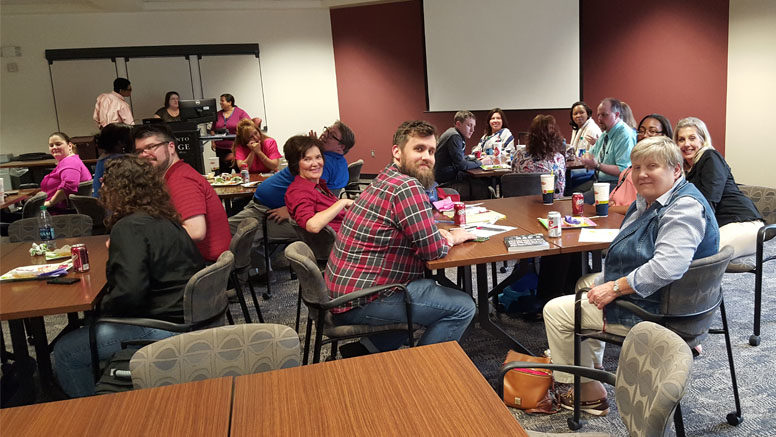To successfully teach at a community college requires a special set of skills.
“You have to be able to motivate, inspire and engage the type of students we enroll,” says John Roueche, president of the Roueche Graduate Center at National American University in Texas. “You’ve got to be a much better teacher than if you’re working at a selective university.”
While there are plenty of applicants with master’s degrees in the subject they want to teach, Roueche says very few come with any training to prepare them to teach at an open-door college.
There were hundreds of university programs for preparing community college faculty in the 1960s and 1970s during the great growth period for community colleges, he says. When that growth period ended, the university programs were disbanded and now there are only about 10 or so left.
In some cases, community colleges have created their own training and mentoring programs to fill that void. Those initiatives are important, Roueche says, because so many community college students are the first in their family to enroll in higher education and have jobs and family responsibilities.
“They need a math instructor who can relate the course material to students in meaningful ways,” he says.
Somebody might be strong in their field, “but how do you step into a developmental education or general education class and make magic happen when the students don’t want to be there? Teachers of those courses must be very good at involving students,” Roueche says.
“It’s a challenge,” he adds. “Hiring is the most important thing we do. If faculty don’t do a good job, students are hurt and the college’s reputation is hurt. If you make a mistake in hiring, you pay a terrible price.”
Active learning
Newly hired faculty at Front Range Community College in Colorado – even if they’ve taught at another community college for years – are required to take part in a two-year professional development experience called Teaching with Purpose. The program is optional for new adjuncts, and the college pays adjuncts who choose to participate, says Cathy Pellish, vice president at the college’s Westminster Campus.
Teaching with Purpose consists of monthly sessions led by experienced faculty who teach their newly hired peers to use active learning, collaborative learning and the flipped classroom approach.
The idea is to have faculty embrace a less lecture-dependent learning environment that encourages creativity, Pellish says. A major part of the program is to ensure that faculty understand student learning outcomes, have the tools to do assessments well and improve the culture of assessment.
Front Range also has an instructional coach program in which four experienced faculty members run seminars for newer peers.
Implementing Pathways
Because Front Range is in the American Association of Community College’s Pathways Project, newly hired faculty are given “intentional time” with deans and department chairs to familiarize them with how guided career pathways are being implemented at the college.
In addition, “reflective practice groups” allow faculty to share ideas and encourage innovation.
“These groups spring up organically around faculty interests,” Pellish says. Last year, a book group was formed that focused on Redesigning America’s Community Colleges by Thomas Bailey, Shanna Smith Jaggars and Davis Jenkins.
Pellish believes the professional development initiatives encourage “peer-to-peer connections across discipline lines.” Providing a sense of consistency among faculty who’ve shared the same experience creates a cohort and has smoothed the implementation of the pathways work.
Cross disciplinary teams have formed to submit grant requests, and “there’s been a greater understanding of the language around our initiatives,” she says. “The work is seeping into the culture.”
A focus on student success
Jackson College in Michigan has an extensive hiring process to ensure new full- and part-time faculty “are really dedicated to teaching and student success,” says Kate Thirolf, dean of business and human services.
A lengthy interview process carried out by a search committee covers such issues as applicants’ commitment to active learning and to teaching students with learning challenges. It’s all tied to the college’s focus on “total commitment to student success” (TSC2) and its mission statement: “Together we inspire and transform lives.”
TSC2 is on posters all over campus, Thirolf says, but it’s more than a slogan. It drives everything done at Jackson and it’s embedded in job descriptions.

A professional development session for new faculty at Jackson College in Michigan. (Photo: Jackson College)
“The interview process is really important to clarify who we are and what we’re looking for,” she notes. Applicants are asked about their teaching philosophy, their perception of the role of community colleges in higher education and evidence of their success in promoting student learning.
Those who get a nod from the search committee are invited to demonstrate how they would teach a lesson in the classroom – anyone on campus can attend that class and about 30 to 40 students usually show up.
“That makes it more real,” Thirolf says.
If candidates get through that hurdle, the next steps are interviews with the provost and the leadership council, which includes the president and vice presidents. At that point, they are asked to select one of the college’s 13 institutional beliefs to speak about, which Thirolf says leads to “a vigorous and thoughtful conversation.”
Building a network
All newly hired staff at Jackson – including people in administration and facilities, as well as faculty – attend a week-long orientation program known as NEO (new employee onboarding) Week.
During the week, they have breakfast with a trustee; meet with the president, leadership council, deans and staff; take campus tours; and learn about student services, guided pathways and other programs.
The week is all about “getting familiar with our culture and connecting with people across the college,” Thirolf says. “By the end of the week, they have a solid network of people they can go to with questions and get advice.”
During their first year, the focus is on ensuring new employees develop a mentorship team – often cross disciplinary – to help them prepare for the faculty portfolio process.
Faculty are required to submit a portfolio to their dean at the end of their second and third years outlining their accomplishments. Portfolios could include copies of positive emails from students; a statement on teaching philosophy; assessment data; samples of lesson plans; and descriptions of activities undertaken to mentor adjuncts or advise students.
Adjuncts, who make up 70 percent of the teaching staff at Jackson, are required to attend an orientation program – and are paid to do so. Those sessions are more about building networks than just giving them a lot of information, which Thirolf likens to “drinking water out of a fire hydrant.”
New adjuncts are invited to student panels, where students talk about what works for them in the classroom.
“The idea is to make sure they are prepared for the community college environment before their first class,” Thirolf says.
The two Saturdays before the fall and winter semester are set aside as “Adjunct Learning Days,” offering professional development. Those sessions are not mandatory, “but they show up because they know it’s worthwhile,” Thirolf says.
Blitz week
At San Jacinto College (SJC) in Texas, all new full-time faculty members are required to attend a New Faculty Academy (NFA). A key part of the academy is the “NFA Blitz,” a weeklong session, 8 a.m. to 4 p.m., before the start of the semester.
“It covers everything they might need to know to survive the first couple of weeks without being lost,” says Martha Robertson, director of the college’s Center for Teaching and Learning. That includes briefings by human resources, safety and other staff; instructions on using Blackboard and classroom technology; information about dual-credit students; and advice on teaching strategies, classroom management and assessments.
The chancellor and deputy chancellor also drop by to chat with the new hires.
“That lets them know we really value them,” Robertson says, noting that one new faculty member, who had worked at another college for 15 years, had never been in the same room with the chancellor.
“Everything we do during blitz week reflects good teaching strategies,” she says. Rather than just lecturing to them, the week is all about engaging new faculty with active learning and group discussions.
Classroom management
The NFA continues throughout the first semester, with group meetings every other Monday afternoon for cohorts of about 50 to 60 people. Each new faculty member is required to read On Course: Strategies for Creating Success in College and in Life by Skip Downing, which they discuss during the academy sessions.
About five to eight members of SJC’s Distinguished Faculty group serve as “NFA ambassadors” and help Robertson plan the sessions, lead activities and serve as informal mentors.
The NFA sessions during the first semester include a “classroom management 101 feature” and book discussions.
“Classroom management is a really big deal with new faculty, especially if they’re brand new,” she says. “Some new hires are fresh out of college or have taught in higher education but not in a community college and don’t have any experience with classroom management.”
During the spring semester of the NFA, instead of meeting together, new faculty met in focused interest groups with experts on topics they plan to incorporate into their classrooms the following year, such as developing and teaching an honors class or using classroom technology effectively.
The best thing about the NFA, participants told Robertson, is “the opportunity for networking and to get to know a lot of people really quickly.”
While SJC doesn’t have data on the effectiveness of the efforts to train new faculty, Robertson believes it contributes to faculty retention.
“They say they feel connected to the college,” she says.

